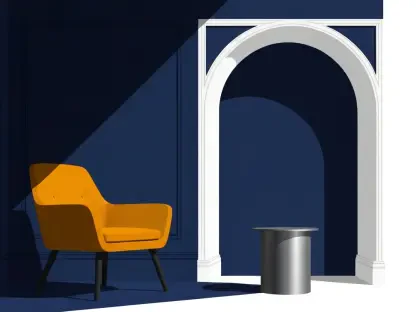Interior design has consistently provided a fascinating lens through which to observe cultural, social, and technological shifts over the decades, reflecting the unique aspirations and challenges of each generation. As societal values transform, so do the preferences in how we style the spaces we inhabit. From the sleek, modernist aspirations of the Baby Boomers to Gen Z’s vibrant embrace of vintage charm, generational tastes in interior design reveal a continual evolution of aesthetics and functionality. This progression not only highlights shifting tastes but also reflects deeper changes in lifestyle priorities, technological integration, and material use over time.
Baby Boomers and Their Influence
Industrial and Futuristic Appeal
Baby Boomers, born between 1946 and 1964, emerged in a period of rapid post-war economic growth, significantly impacting design preferences with a penchant for industrial and futuristic aesthetics. During this era, interior design was markedly influenced by notions of progress and modernity, often materialized through the use of materials like vinyl and chrome. These materials lent a distinctly sleek and polished appearance to furnishings, manifesting a futuristic dream that resonated with the technological optimism prevalent at the time.
Furniture pieces often included bold forms and geometries, resonating with modernist architectural trends. The epitome of this movement was represented by utilitarian items such as TV trays and gleaming Formica countertops, elements widely regarded at the time as sleek symbols of innovation and convenience. However, these characteristics are viewed today with a certain nostalgic distance, often criticized for creating atmospheres that some see as impersonal or uninviting, despite their original intent of embodying progress and efficiency.
Nostalgia and Midcentury Modern
While Baby Boomers have shed some of the futuristic design trends of their youth, many retain a fondness for elements drawn from midcentury modern design. This style is characterized by its functional yet aesthetically pleasing furniture, often supporting minimalist spaces defined by clean lines. The time was ripe for experimentation with color, resulting in the iconic and oft-recalled palettes of avocado green, rust, and gold hues, prevalent in the era’s interior design.
Even with its nostalgic allure, some iconic details from this period are remembered with a playful affection tinged with critique. Shag carpets and excessive use of bold color schemes are remembered as emblematic of the era’s bravado, drawing as much revulsion as appreciation today. Nevertheless, the midcentury modern style has experienced a resurgence, valued for its minimalistic elegance and functional beauty, allowing it to continually captivate new admirers from later generations.
Generation X’s Quest for Authenticity
Disdain for Faux Luxury
Generation X, those born between 1965 and 1980, grew up amid economic upheavals and rapid technological changes, fostering an appreciation for the authentic over the ostentatious. Architectural and interior design styles that flourished during this era often incorporated bold colors and industrial materials, expressing an urban aesthetic that flirted with kitsch. However, this generation quickly tired of decor perceived as disingenuous—a sentiment driven by the rise of “faux luxury,” where imitation took precedence over genuine innovation.
This aversion manifested in critiques against features like plastic wood-paneled basements or oversized entertainment centers, often regarded as superficial embellishments rather than substantive styling. An attachment to sincerity in stylistic choices underscores Generation X’s approach to interior design, aligning with a preference for structures and decor that convey authenticity and permanence. The popularity of genuine wood finishes, stainless steel, and exposed elements displays a characteristic gravitation towards authenticity and straightforwardness in design.
Transition to Minimalism
As Generation X matured, there emerged a noticeable pivot towards minimalism, distancing itself from the over-the-top styles of the preceding decades. Minimalistic design, with its focus on simplicity and uncluttered spaces, appealed to the generation’s desires for clean lines and functional aesthetics. The thematic shift also accompanied a growing environmental consciousness, with many seeking sustainable furniture and decor produced from responsibly sourced materials.
In rejecting ornate Victorian styles and the complexities of maximalism, Generation X gravitated toward the more straightforward, stripped-down confines of minimalist spaces, emphasizing practical use over decorative flourish. Embracing neutral palettes and subtle textures, this design philosophy paved the way for a calming, orderly environment ideal for fostering tranquility amidst the chaos of daily life. The influence of minimalism has endured, serving as a foundational aspect of the stylistic preferences observed in the following generations, while adaptation to contemporary needs and technologies continues to evolve.
Millennial Balancing Act
Minimalist Aesthetics in the Modern Era
The Millennial generation, spanning from 1981 to 1996, is defined by an upbringing immersed in digital advancement, global connectivity, and increasingly urban lifestyles. Their design preferences reflect these dynamics, evidenced by a general move toward minimalism paired with a personal touch. Millennials often view spaces through a lens of functionality and aesthetic harmony, seeking out designs that can cater to both aspects simultaneously.
Reflectively skeptical of the clunky, overly thematic interiors of the 1980s, Millennials advocate for decor that emphasizes simplicity, openness, and personalization. Minimalist aesthetics are favored, incorporating elements like natural light, modest furniture sizes, and multi-functional rooms. There is an evident rejection of design that promotes clutter or is overly ornate, a key sentiment that has shaped Millennial design ethos away from cumbersome and dated traditions.
A Focus on Sustainability and Longevity
Amidst the global push towards sustainability, Millennials have widely embraced eco-friendly design choices, championing furniture made from sustainable materials and leaning toward timeless pieces that affirm durability. There is a conscientious disdain for “fast furniture,” characterized by cheaply made, disposable decor known for its seasonal appeal but lacking in long-term viability. The prioritization of quality over quantity helps create enduring spaces that resonate with individuality and ethical responsibility.
This generation’s inclination toward environmentally friendly design encompasses not only material choices but also energy-efficient technologies. Millennials incorporate smart-home devices to seamlessly blend aesthetics with utility, promoting an integrated lifestyle conducive to comfort and efficiency. As a result, the spaces curated by this generation are notable for their capacity to align personal taste with broader ethical and technological advancements, further underscoring their approachability and relevance in today’s design landscape.
Gen Z’s Bold Redefinition
Colorful and Eclectic Embrace
Encompassing individuals born from 1997 to 2012, Generation Z is at the forefront of bold aesthetics, advocating for design that champions individuality and vivid expression. Unlike previous generations that may have embraced more bland or reserved palettes, Gen Z welcomes the blend of colors, textures, and patterns into their interior designs, seeking spaces that inspire creativity and distinctly reflect personal identity. This dynamic interpretation of spaces marks a departure from homogeneous styles, favoring multifaceted eclecticism.
A notable shift occurs as this generation moves away from the all-gray and farmhouse styles emblematic of previous trends, opting for environments rich with character and narrative. Vintage charm and transitional designs make a pronounced comeback, pairing contemporary function with classic beauty to result in unique and deeply personal spaces. The manifestation of individuality and creativity becomes central, seamlessly integrating vintage elements that convey stories alongside contemporary updates that highlight flair and vibrancy.
A Commitment to Quality and Storytelling
Gen Z exhibits a distinct preference for objects and decor that embody craftsmanship, durability, and meaningful origins over mass-produced and disposable adversaries. This perspective aligns with an increased awareness of social and environmental responsibility, advocating for handmade or ethically produced items with stories worth telling. Design approaches that incorporate durability and narrative foster connections with the spaces inhabited—a crucial factor in Gen Z’s interior design philosophy.
The fusion of digital innovation with tangible experiences is also a hallmark of Gen Z’s ethos. Integrating technology into interiors, from smart lighting to augmented reality design processes, becomes more commonplace, aligning with their digitally native experiences. While their aesthetic may appear unconventional or daring to some, Gen Z interior design reflects a dedication to creating dynamic and genuine environments that embrace technological advancements while cherishing stories of the past, all underscored by an unwavering commitment to authenticity and personal truth.
The Collective Evolution of Interior Design
From Synthetics to Authenticity
Interior design preferences across varying generations have marked an intriguing evolution from synthetic embellishments towards a strong appreciation for authentic materials and craftsmanship. The overarching trend reveals a gradual but definitive shift, spurred by changing societal norms and values that dictate our interactions with our environments. As such, a broader consensus has emerged, emphasizing personal expression through quality, aesthetically pleasing interiors rather than predefined, conventional aesthetics.
This journey has been seasoned with a consistent drive towards practicality and functionality, transitioning away from superficial stylings seen in previous eras. Factors like increased environmental consciousness, technological capabilities, and appreciation for heritage have informed design choices, as subsequent generations seek to create spaces that eschew temporal trends for lasting impact.
Telling Stories Through Spaces
Interior design has long served as an intriguing lens through which to view the cultural, social, and technological transformations across the decades, encapsulating the distinct aspirations and challenges faced by each generation. As the values and ideals of society change, so too do the ways we choose to decorate and set up our living spaces. For instance, the Baby Boomers sought sleek and modern interiors, reflecting their forward-thinking spirit. In contrast, Gen Z has developed a fondness for vintage styles, embracing the character and charm of bygone eras.
This evolving taste in interior design not only marks changing aesthetic preferences but also signals deeper shifts in lifestyle priorities, integration of technology, and the materials deemed suitable or trendy at different times. By examining these stylistic choices, one can glean insights into the generational shifts in what’s important—such as an increased focus on sustainability or connectivity within our homes. Over time, interior design trends reveal how each generation navigates their unique societal context, balancing personal expression with broader cultural narratives. This progression underscores the dynamic nature of human preferences and their interplay with advancements, offering a window into the past that shapes our present living environments.









